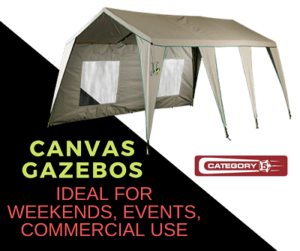If you are looking at buying a family tent you may be confused by the array of different tent fabric, from polyester canvas, nylon, to poly/cotton, and a collection of different brand names.
Different tent fabric has its strengths and weaknesses. Which tent material is the best will depend on it’s intended application. For instance, do you need a tent that is lightweight, compact and easy to transport (eg to carry in a backpack), or are you looking for a tent as a comfortable holiday home for an extended stay?
The vast majority of tents are made out of man-made fabrics and are made in Asia, either polyester or nylon based. For family tents, you will typically find polyester because it is cheaper than Nylon per square metre. Nylon is used for lightweight backpacking tents because it is very light, folds up small and has fine woven fibres for maximum strength, however it is more expensive than polyester materials per square metre. Polyester and Nylon made tents are often the cheapest options available, but are also less durable.
Advantages of Polyester material for tents:
- Cheaper – More affordable tents are made with man-made fabrics.
- Lighter – from smaller backpacking tents to even larger family tents, these man-made fabrics are a lot lighter and less bulky than natural based fabrics, making them lighter to carry.
- Quick to dry out.
- Low maintenance.
On the other hand polyester tents are not good insulators, compared to poly/cotton. This means the tents can get very hot in summer, and chilly during colder weather. Also, the material is not naturally breathable. Condensation can build up on the inside of a polyester tent – sometimes enough to cause puddles due to the moisture in the air. These types of tents will deteriorate much quicker than canvas tents, and will fade quickly due to exposure to UV. The light colour materials are often very bright and glowing with light filtering into the tent at 6am when the sun comes up, whereas a canvas tent will be darker inside providing the opportunity to sleep in longer. Some polyester tents on the market are now being made with an extra black lining on the inside (called Darkroom) to block out the sunlight. A clever marketing idea but of course this concept is more expensive, and poly/cotton canvas tents do this naturally without the need for any extra coating. Polyester tents flap around in the wind creating extra noise at night, whereas canvas tents stand firm and are quiet, giving greater stability, less movement and a peaceful nights sleep.
Poly/cotton canvas is the traditional tent fabric, and offers many terrific qualities that have stood the test of time. In environments where harsh elements such as scorching summer heat, UV exposure, humidity, wind, and rain take their toll, canvas shelters are the obvious choice over all others. Tents advertised as ‘canvas’ or ‘cotton’ are actually made from the same thing. The poly/cotton canvas used in our dome tents is a combination of fibres to offer the best possible performance characteristics for abrasian resistance, tear strength, UV and fade resistance, heat resistance, and water resistance and has been extensively tested for performance in harsh conditions both in Australia and South Africa.
Advantages of poly/cotton canvas for tents:
- Cotton insulates better than man made synthetic materials. You won’t get as hot on a warm day, nor as cold when it is chilly.
- Cotton is a breathable fabric and can absorb water; meaning that you are less likely to have an issue with condensation, extra humidity and heat inside the tent compared to synthetic man made materials.
- Due to its weight and insulation properties, canvas/cotton tents can be quieter, and not as noisy if there is a breeze.
- The fabric can last a long time and is more resistant to harmful UV rays.
- The poly/cotton canvas has a much higher tear strength and burst strength meaning less prone to tears, punctures, and repairs.
- A double skin roof line (a tent with an extra fly sheet over the top) provides extra protection and insulation from the elements. This keeps the tent cleaner, cooler, dryer than any single skin canvas tent can do. Which is why almost every one of our canvas tents comes with an inner tent and an extra canvas fly sheet over the roof.
- Value for money. We are often drawn to the cheapest price. But we also often realise that when we study the components and performance characteristics, the cheapest price is often not the best choice. The value is recognised when the product is suitable for use over and over again without fear of wearing out too quickly or easy damage. That’s when true value for money is realised and is why we wholeheartedly endorse high quality double skin canvas dome tents over second rate alternatives.
For more information on specific models and different sizes, including high quality portable canvas gazebos and shelters, visit www.diamantina.net.au.



